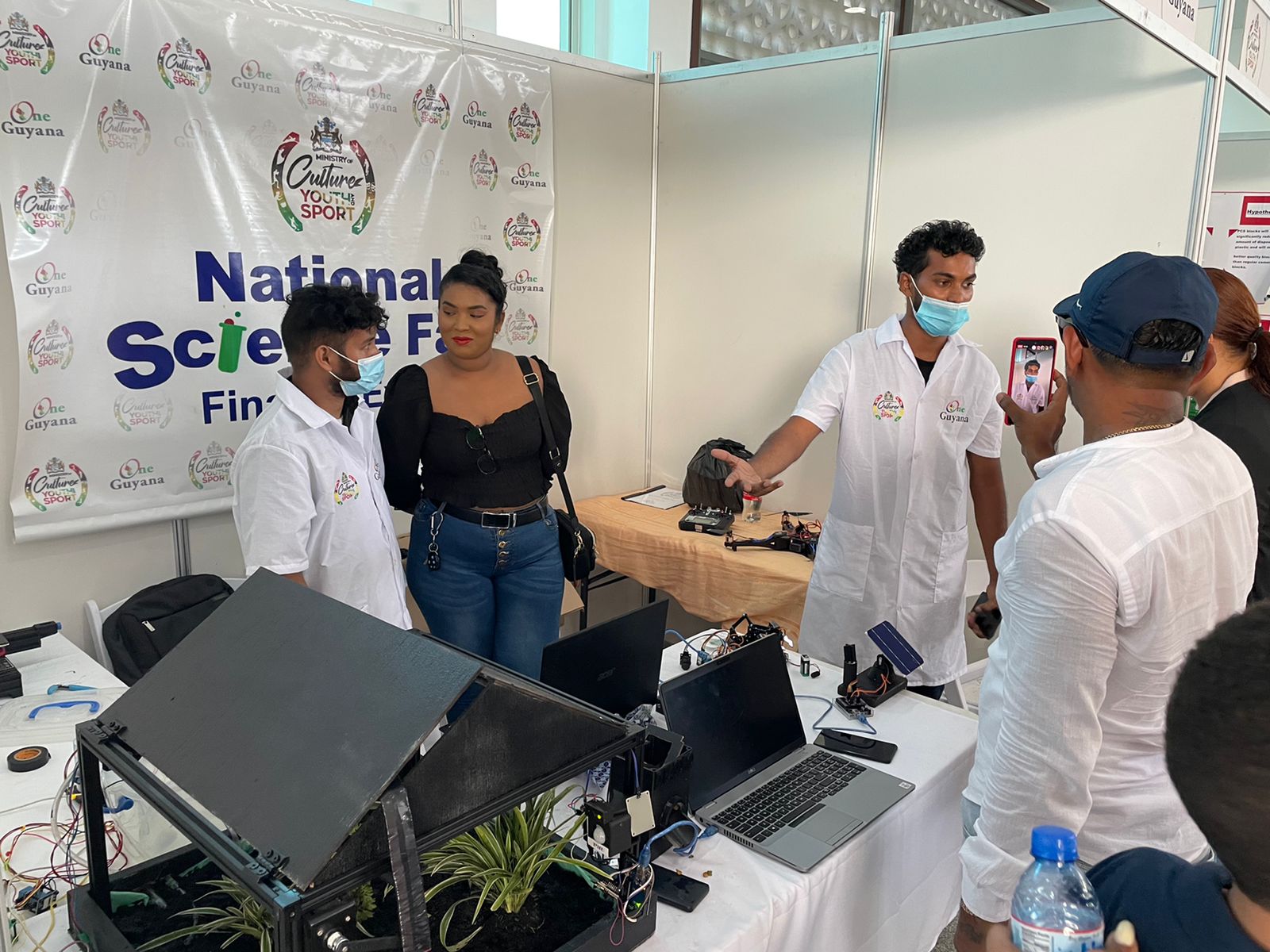 By Vishani Ragobeer
By Vishani Ragobeer
Guyanese youth, from all across the country, brainstormed solutions for some of the problems faced every day and presented those at the National Science Fair.
For some, it means aiding the country’s frail electricity company or getting people to eat healthier. For many though, saving the earth is a crucial focus.
“We realised that there is a high rate of deforestation globally, as well as a high usage of single-use plastics, so our group found a sustainable and cheap way of making paper and paper-based products using grass,” said Shamar Sukhu, a university student from Region Six (East Berbice-Corentyne).
Sukhu’s group, the Environmental Entrepreneurs, proposed extracting chlorophyll from grass and drying what remains to make paper-like materials.
 making paper from grass (Photo: News Room/ August 27, 2022) </p>
<p>” data-medium-file=”https://newsroom.gy/wp-content/uploads/2022/08/Environmental-Entrepreneurs-300×300.jpeg” data-large-file=”https://newsroom.gy/wp-content/uploads/2022/08/Environmental-Entrepreneurs-1024×1024.jpeg” loading=”lazy” class=” wp-image-149151″ src=”https://newsroom.gy/wp-content/uploads/2022/08/Environmental-Entrepreneurs-1024×1024.jpeg” alt=”” width=”941″ height=”941″ /><figcaption id=) Shamar Sukhu, a university student from Region Six (East Berbice-Corentyne) making paper from grass (Photo: News Room/ August 27, 2022)
Shamar Sukhu, a university student from Region Six (East Berbice-Corentyne) making paper from grass (Photo: News Room/ August 27, 2022)Because grass is often cut and burnt, they hope this project would help to save trees. This is important to them because trees trap carbon dioxide, a harmful gas that could cause further harm to the environment once released into the atmosphere.
By offering an alternative to single-use plastics like straws and cups, they also hope to wean off Guyana’s dependence on an industry known to emit significant volumes of carbon dioxide – the plastic industry.
At the western end of the Arthur Chung Conference Centre where the science fair was held, a group of university graduates had another idea.
“We understand the problems associated with fossil fuel use,” the Quadsector’s team leader Shawayne Henry said.
The fossil fuel industry is notorious for emitting carbon dioxide and other harmful greenhouse gases that contribute to the climate crisis. For countries like Guyana, that crisis means more rising sea-level and flooding on the low coastal plain where about 90 per cent of the population resides. It threatens lives and livelihoods.
Henry acknowledged that using more sustainable or renewable energy sources is crucial to displacing fossil fuel use.
And so, he asks, “Did you ever think that sustainable energy was just going to fall from the sky?”
Surprisingly, his answer was yes. The Quadsector team, quite literally, found their solution falling from the sky. Rainfall.
By harnessing vibrations of raindrops crashing against a special metal panel, they believe energy can be created in the same way energy is harnessed from the sun or from the wind.
 </p>
<p>” data-medium-file=”https://newsroom.gy/wp-content/uploads/2022/08/Shawayne-Henry-300×225.jpeg” data-large-file=”https://newsroom.gy/wp-content/uploads/2022/08/Shawayne-Henry-1024×768.jpeg” loading=”lazy” class=”size-large wp-image-149149″ src=”https://newsroom.gy/wp-content/uploads/2022/08/Shawayne-Henry-1024×768.jpeg” alt=”” width=”1024″ height=”768″ /><figcaption id=) Quadsector’s science project that promises to use rainfall to generate energy (Photo: News Room/ August 28, 2022)
Quadsector’s science project that promises to use rainfall to generate energy (Photo: News Room/ August 28, 2022)With appropriate studies of Guyana’s rainfall patterns and energy consumption habits, Henry and his group of friends believe that they can offer Guyana another solution, or at least another addition, to the energy mix currently being pursued.
That energy mix is touted as the tool to help Guyana slash its fossil fuel use by 70 per cent by 2030 while meeting tripling energy demand. It involves harnessing the natural gas produced in the oil blocks offshore and using a combination of hydro, wind and solar power.
Now, the Quadsector team stands firmly behind their project and its merits. It’s renewable, it doesn’t emit harmful gases and it could be a cheaper energy alternative.
“I think it has a promising future for Guyana, the Caribbean and the world at large,” the young scientist said.
Young, soon-to-be Fourth Form students from the Anna Regina Secondary school believe that even one small project at a time can help save the earth.
Their solar-heating project, made using an umbrella and aluminium foil, might not be a large-scale project that will displace emissions or save the trees, but it illustrates their concern for the environment.
Student Vanisha Lall emphasises, “Climate change is bothering us.”
 </p>
<p>” data-medium-file=”https://newsroom.gy/wp-content/uploads/2022/08/Anna-Regina-300×225.jpeg” data-large-file=”https://newsroom.gy/wp-content/uploads/2022/08/Anna-Regina-1024×768.jpeg” loading=”lazy” class=”size-large wp-image-149150″ src=”https://newsroom.gy/wp-content/uploads/2022/08/Anna-Regina-1024×768.jpeg” alt=”” width=”1024″ height=”768″ /><figcaption id=) Soon-to-be- fourth form students of the Anna Regina Secondary School (Photo: News Room/ August 27, 2022)
Soon-to-be- fourth form students of the Anna Regina Secondary School (Photo: News Room/ August 27, 2022)Months away from this year’s global climate talks, COP27, last weekend’s science fair illustrated just how focused these Guyanese youth are on their role in slowing the climate crisis.
Like these youth, the country’s Finance Minister Dr. Ashni Singh recently told the National Assembly that the government hopes to keep the trees intact by getting payments from countries or companies.
He explained that those funds will be used to help the country gradually shift away from its long-standing dependence on diesel and other fuel.
These efforts are being pursued through a new ambitious development plan, the updated Low Carbon Development Strategy, which was passed in the House earlier this month.

